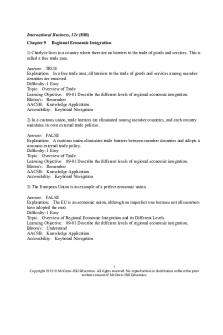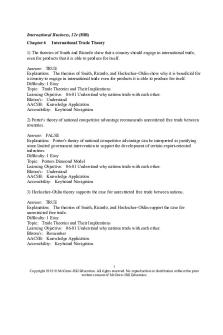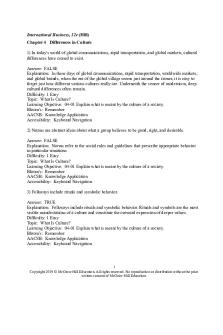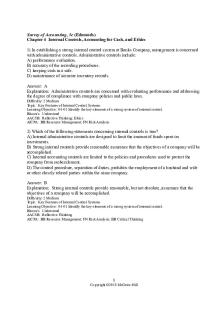Colquitt 6e Chapter 09 TB Answer Key for the student PDF

| Title | Colquitt 6e Chapter 09 TB Answer Key for the student |
|---|---|
| Author | wisi valeed |
| Course | Organizational behaviour |
| Institution | Panjab University |
| Pages | 59 |
| File Size | 347 KB |
| File Type | |
| Total Downloads | 16 |
| Total Views | 188 |
Summary
the organization behaviour is the most imp field of the life for the manager for their stuy in the field of the manager...
Description
Organizational Behavior, 6e (Colquitt) Chapter 9 Personality and Cultural Values 1) Personality refers to the structures and propensities inside people that explain their characteristic patterns of thought, emotion, and behavior. Answer: TRUE Explanation: Personality refers to the structures and propensities inside people that explain their characteristic patterns of thought, emotion, and behavior. Personality creates people's social reputations—the way they are perceived by friends, family, coworkers, and supervisors. Difficulty: 1 Easy Topic: Individual differences Learning Objective: 09-01 What is personality? What are cultural values? Bloom's: Remember AACSB: Knowledge Application Accessibility: Keyboard Navigation 2) People's beliefs create their social reputations. Answer: FALSE Explanation: Personality creates people's social reputations—the way they are perceived by friends, family, coworkers, and supervisors. In this way, personality captures what people are like. Difficulty: 2 Medium Topic: Individual differences Learning Objective: 09-01 What is personality? What are cultural values? Bloom's: Remember AACSB: Knowledge Application Accessibility: Keyboard Navigation 3) Felix started his new job about a month ago. When asked, he says he likes most of his coworkers. One of them, though, is mean-spirited, obnoxious, petty, and belligerent. Felix is describing his coworker's social traits. Answer: FALSE Explanation: Felix is describing his coworker's personality traits. Traits are defined as recurring regularities or trends in people's responses to their environment. Difficulty: 1 Easy Topic: Individual differences Learning Objective: 09-01 What is personality? What are cultural values? Bloom's: Apply AACSB: Knowledge Application Accessibility: Keyboard Navigation
1 Copyright 2019 © McGraw-Hill Education. All rights reserved. No reproduction or distribution without the prior written consent of McGraw-Hill Education.
4) In the context of the Big Five taxonomy, a submissive person is said to be an extravert. Answer: FALSE Explanation: According to the Big Five taxonomy, an extravert does not show signs of being submissive. Difficulty: 2 Medium Topic: Big Five Model Learning Objective: 09-02 What are the "Big Five"? Bloom's: Remember AACSB: Knowledge Application Accessibility: Keyboard Navigation 5) Miriam is known as a person who is talkative. In the context of the Big Five taxonomy, the extraversion personality dimension best describes Miriam. Answer: TRUE Explanation: Extraverts are talkative, sociable, passionate, assertive, bold, and dominant. Difficulty: 2 Medium Topic: Big Five Model Learning Objective: 09-02 What are the "Big Five"? Bloom's: Apply AACSB: Knowledge Application Accessibility: Keyboard Navigation 6) Those with low scores on neuroticism are more likely to demonstrate Type A behavior patterns. Answer: FALSE Explanation: Individuals who score high on neuroticism are more likely to demonstrate Type A behavior patterns that have been shown to affect employees' health and their ability to manage stressful environments. Difficulty: 2 Medium Topic: Big Five Model Learning Objective: 09-02 What are the "Big Five"? Bloom's: Remember AACSB: Knowledge Application Accessibility: Keyboard Navigation
2 Copyright 2019 © McGraw-Hill Education. All rights reserved. No reproduction or distribution without the prior written consent of McGraw-Hill Education.
7) Extraversion changes quite significantly over a person's life span. Answer: FALSE Explanation: Extraversion remains quite stable throughout a person's life. Difficulty: 2 Medium Topic: Big Five Model Learning Objective: 09-03 Is personality driven by nature or by nurture? Bloom's: Remember AACSB: Knowledge Application Accessibility: Keyboard Navigation 8) Conscientious people are dependable, organized, reliable, ambitious, hardworking, and persevering. Answer: TRUE Explanation: Conscientious people are dependable, organized, reliable, ambitious, hardworking, and persevering. Difficulty: 1 Easy Topic: Big Five Model Learning Objective: 09-03 Is personality driven by nature or by nurture? Bloom's: Remember AACSB: Knowledge Application Accessibility: Keyboard Navigation 9) Of the Big Five, openness to experience is the easiest to judge in zero acquaintance situations. Answer: FALSE Explanation: Of the Big Five, extraversion is the easiest to judge in zero acquaintance situations —situations in which two people have only just met. Difficulty: 2 Medium Topic: Big Five Model Learning Objective: 09-03 Is personality driven by nature or by nurture? Bloom's: Understand AACSB: Knowledge Application Accessibility: Keyboard Navigation
3 Copyright 2019 © McGraw-Hill Education. All rights reserved. No reproduction or distribution without the prior written consent of McGraw-Hill Education.
10) From the perspective of job performance, neuroticism is the most important of the Big Five. Answer: FALSE Explanation: Conscientiousness is the most important of the Big Five from the perspective of job performance; neuroticism is the second most important. Difficulty: 2 Medium Topic: Big Five Model Learning Objective: 09-03 Is personality driven by nature or by nurture? Bloom's: Remember AACSB: Knowledge Application Accessibility: Keyboard Navigation 11) Neurotic people tend to have an external locus of control. Answer: TRUE Explanation: Neurotic people tend to hold an external locus of control, meaning that they often believe that the events that occur around them are driven by luck, chance, or fate. Difficulty: 2 Medium Topic: Big Five Model Learning Objective: 09-03 Is personality driven by nature or by nurture? Bloom's: Remember AACSB: Knowledge Application Accessibility: Keyboard Navigation 12) In the context of the Big Five taxonomy, openness to experience is positively related to performance across all occupations. Answer: FALSE Explanation: Much like agreeableness and extraversion, the traits associated with openness are beneficial in some jobs but not others. As a result, openness is not related to job performance across all occupations. Difficulty: 2 Medium Topic: Big Five Model Learning Objective: 09-03 Is personality driven by nature or by nurture? Bloom's: Remember AACSB: Knowledge Application Accessibility: Keyboard Navigation
4 Copyright 2019 © McGraw-Hill Education. All rights reserved. No reproduction or distribution without the prior written consent of McGraw-Hill Education.
13) The most appropriate use of the Myers-Briggs Type Indicator is in a team-building context. Answer: TRUE Explanation: The most appropriate use of the Myers-Briggs Type Indicator is in a team-building context to help different members understand their varying approaches to accomplishing tasks. Difficulty: 2 Medium Topic: Myer-Briggs Type Indicator (MBTI) Learning Objective: 09-04 What taxonomies can be used to describe personality, other than the Big Five? Bloom's: Understand AACSB: Knowledge Application Accessibility: Keyboard Navigation 14) Holland's RIASEC model focuses on people's vocational interests. Answer: TRUE Explanation: Holland's RIASEC model focuses on people's vocational interests. Difficulty: 1 Easy Topic: Individual differences Learning Objective: 09-04 What taxonomies can be used to describe personality, other than the Big Five? Bloom's: Understand AACSB: Knowledge Application Accessibility: Keyboard Navigation 15) Artistic people tend to enjoy abstract, analytical, theory-oriented tasks. Answer: FALSE Explanation: Artistic people tend to enjoy entertaining and fascinating others using imagination. They are usually original, independent, impulsive, and creative. Difficulty: 1 Easy Topic: Individual differences Learning Objective: 09-04 What taxonomies can be used to describe personality, other than the Big Five? Bloom's: Remember AACSB: Knowledge Application Accessibility: Keyboard Navigation
5 Copyright 2019 © McGraw-Hill Education. All rights reserved. No reproduction or distribution without the prior written consent of McGraw-Hill Education.
16) Holland's RIASEC model includes the personality dimensions of conscientiousness and neuroticism. Answer: FALSE Explanation: Conscientiousness and neuroticism are part of the Big Five model. Difficulty: 2 Medium Topic: Individual differences Learning Objective: 09-04 What taxonomies can be used to describe personality, other than the Big Five? Bloom's: Remember AACSB: Knowledge Application Accessibility: Keyboard Navigation 17) Low-power distance cultures prefer that power be distributed uniformly where possible, in an egalitarian fashion. Answer: TRUE Explanation: Low-power distance cultures prefer that power be distributed uniformly where possible, in a more egalitarian fashion. Difficulty: 2 Medium Topic: Cultural values Learning Objective: 09-05 What taxonomies can be used to describe cultural values? Bloom's: Remember AACSB: Knowledge Application Accessibility: Keyboard Navigation 18) Conscientiousness has a moderate positive effect on performance. Answer: TRUE Explanation: Conscientiousness has a moderate positive effect on performance. Difficulty: 1 Easy Topic: Big Five Model Learning Objective: 09-06 How does personality affect job performance and organizational commitment? Bloom's: Remember AACSB: Knowledge Application Accessibility: Keyboard Navigation
6 Copyright 2019 © McGraw-Hill Education. All rights reserved. No reproduction or distribution without the prior written consent of McGraw-Hill Education.
19) Christina is attending a business meeting at a client's office. Some of the other attendees are formally dressed; others are in shorts and T-shirts. The table is round instead of rectangular, so there is no head to let her know who the most important person at the meeting is. There is no agenda to let her know what the important topics are today. Her personality is most likely to drive her behavior in this situation. Answer: TRUE Explanation: This example describes a weak situation, one with few behavioral cues. Personality variables tend to be more significant drivers of behaviors in weak situations where there are few clues as to the expected behavior. Difficulty: 2 Medium Topic: Individual differences Learning Objective: 09-06 How does personality affect job performance and organizational commitment? Bloom's: Apply AACSB: Knowledge Application Accessibility: Keyboard Navigation 20) Personality tests are valid and reliable assessments that have been subjected to scientific investigation. Answer: FALSE Explanation: There is no guarantee that the personality tests used by a company are actually valid assessments because few of them have been subject to scientific investigation. Difficulty: 1 Easy Topic: Individual differences Learning Objective: 09-06 How does personality affect job performance and organizational commitment? Bloom's: Remember AACSB: Knowledge Application Accessibility: Keyboard Navigation
7 Copyright 2019 © McGraw-Hill Education. All rights reserved. No reproduction or distribution without the prior written consent of McGraw-Hill Education.
21) Which of the following scenarios demonstrates personality? A) Dalton can perform any mechanical task well. B) Lulu scores extremely well on an intelligence test. C) Monte lacks coordination and performs poorly in all sports. D) Shanda is generally friendly, likable, and calm under pressure. E) Phoebe volunteers in the crisis shelter like everyone in her church. Answer: D Explanation: Personality refers to the structures and propensities inside people that explain their characteristic patterns of thought, emotion, and behavior. It creates people's social reputation— the way they are perceived by friends, family, coworkers, and supervisors. Difficulty: 2 Medium Topic: Individual differences Learning Objective: 09-01 What is personality? What are cultural values? Bloom's: Apply AACSB: Knowledge Application Accessibility: Keyboard Navigation 22) Kevin fidgets and taps on things, sighs often, squirms, constantly checks the time, and yells at people when they ask him how a project is going. The people who work with Kevin perceive him as uptight, mean, anxious, and rude. These perceptions are primarily formed by Kevin's A) abilities. B) perception. C) personality. D) ethnocentrism. E) cultural values. Answer: C Explanation: Personality refers to the structures and propensities inside people that explain their characteristic patterns of thought, emotion, and behavior. It creates people's social reputation— the way they are perceived by friends, family, coworkers, and supervisors. Difficulty: 2 Medium Topic: Individual differences Learning Objective: 09-01 What is personality? What are cultural values? Bloom's: Apply AACSB: Knowledge Application Accessibility: Keyboard Navigation
8 Copyright 2019 © McGraw-Hill Education. All rights reserved. No reproduction or distribution without the prior written consent of McGraw-Hill Education.
23) ________ refer(s) to the structures and propensities inside a person that explain his or her characteristic patterns of thought, emotion, and behavior. A) Personality B) Cultural values C) Attributions D) Ethnocentrism E) Perception Answer: A Explanation: Personality refers to the structures and propensities inside people that explain their characteristic patterns of thought, emotion, and behavior. It creates people's social reputation— the way they are perceived by friends, family, coworkers, and supervisors. Difficulty: 1 Easy Topic: Individual differences Learning Objective: 09-01 What is personality? What are cultural values? Bloom's: Remember AACSB: Knowledge Application Accessibility: Keyboard Navigation 24) Personality is a collection of multiple A) abilities. B) traits. C) aptitudes. D) emotions. E) capacities. Answer: B Explanation: Personality is a collection of multiple traits. Traits are defined as recurring regularities or trends in people's responses to their environment. Difficulty: 1 Easy Topic: Traits Learning Objective: 09-01 What is personality? What are cultural values? Bloom's: Remember AACSB: Knowledge Application Accessibility: Keyboard Navigation
9 Copyright 2019 © McGraw-Hill Education. All rights reserved. No reproduction or distribution without the prior written consent of McGraw-Hill Education.
25) Traits are defined as A) recurring regularities or trends in people's responses to their environment. B) shared beliefs about desirable end states or modes of conduct in a given culture. C) tendencies to regard new situations as a challenge and to adjust behaviors to meet that challenge. D) dispositional tendencies to experience pleasant, engaging moods such as enthusiasm, excitement, and elation. E) the structures and propensities inside people that explain their characteristic patterns of thought, emotion, and behavior. Answer: A Explanation: Traits are defined as recurring regularities or trends in people's responses to their environment. Adjectives such as responsible, easygoing, polite, and reserved are examples of traits that can be used to summarize someone's personality. Difficulty: 1 Easy Topic: Traits Learning Objective: 09-01 What is personality? What are cultural values? Bloom's: Remember AACSB: Knowledge Application Accessibility: Keyboard Navigation 26) Personality traits are a function of both your A) values and beliefs. B) beliefs and environment. C) environment and genes. D) genes and perceptions. E) culture and beliefs. Answer: C Explanation: Personality traits are a function of both your genes and your environment. Difficulty: 1 Easy Topic: Individual differences Learning Objective: 09-01 What is personality? What are cultural values? Bloom's: Remember AACSB: Knowledge Application Accessibility: Keyboard Navigation
10 Copyright 2019 © McGraw-Hill Education. All rights reserved. No reproduction or distribution without the prior written consent of McGraw-Hill Education.
27) Arney has been retained by Fluffy Soft Programmers to hire a new worker because he is an expert at personality types and their effect on job performance. Which one of the following interviewees should Arney hire? A) Joy, who likes to work hard until a task is completely finished B) Theresa, who has very complex ideas and constantly seeks answers C) Linda, who goes out of her way to help others and show them respect D) Barbara, who talks to everyone and likes to be in the middle of the action E) Andrea, who gets easily jealous and worries that she is not good enough to do her job Answer: A Explanation: Joy has conscientiousness, which is the trait with the most influence on job performance. Difficulty: 3 Hard Topic: Big Five Model Learning Objective: 09-02 What are the "Big Five"? Bloom's: Apply AACSB: Analytical Thinking Accessibility: Keyboard Navigation 28) Which of the following scenarios describes a worker with a neurotic personality? A) Raul greets everyone entering the office with a handshake and a funny story. B) Lynn stays two hours after closing all week to complete her blueprints perfectly. C) Tyler envisions and then experiments with a new approach to do his job every week. D) David takes on a substantial part of Jo's workload just to help her and everyone on the team have a pleasant day. E) Amy yells at Jacob to go away when he asks her how she is doing, then brings him coffee with a big smile an hour later. Answer: E Explanation: Amy shows moodiness as part of her neuroticism. Difficulty: 3 Hard Topic: Big Five Model Learning Objective: 09-02 What are the "Big Five"? Bloom's: Apply AACSB: Analytical Thinking Accessibility: Keyboard Navigation
11 Copyright 2019 © McGraw-Hill Education. All rights reserved. No reproduction or distribution without the prior written consent of McGraw-Hill Education.
29) Herb's office is impeccably organized. Herb always shows up on time and can be counted to volunteer when someone is needed to go above and beyond usual duties. Herb says he will run the company someday, and he is willing to put in as many hours and as much suffering as it takes to get there. Herb exemplifies the personality trait of A) neuroticism. B) extraversion. C) agreeableness. D) conscientiousness. E) openness to experience. Answer: D Explanation: The Big Five personality dimensions include conscientiousness, agreeableness, neuroticism, openness to experience, and extraversion. Conscientious people are hard-working organized, and ambitious. Difficulty: 2 Medium Topic: Big Five Model Learning Objective: 09-02 What are the "Big Five"? Bloom's: Apply AACSB: Knowledge Application Accessibility: Keyboard Navigation 30) Which of the following is a dimension of the Big Five taxonomy? A) integrity B) motivation C) extraversion D) veiled purpose E) locus of control Answer: C Explanation: The Big Five personality dimensions include conscientiousness, agreeableness, neuroticism, openness to experience, and extraversion. Difficulty: 1 Easy Topic: Big Five Model Learning Objective: 09-02 What are the "Big Five"? Bloom's: Remember AACSB: Knowledge Application Accessibility: Keyboard Navigation
12 Copyright 2019 © McGraw-Hill Education. All rights reserved. No reproduction or distribution without the prior written consent of McGraw-Hill Education.
31) Quincy is always wondering about why things happen, how things work, and what would happen if something was different. He thinks of exciting possibilities that are often outside the box. He is described by his friends as classy and eloquent. Quincy is probably high on the trait of A) openness to experience. B) conscientiousness. C) neuroticism. D) extraversion. E) introversion. Answer: A Explanation: Open people are curious, imaginative, creative, complex, refined, and sophisticated. Difficulty: 2 Medium Topic: Big Five Model Learning Objective: 09-02 What are the "Big Five"? Bloom's: Apply AACSB: Knowledge Application Accessibility: Keyboard Navigation 32) Kartik never raises his voice or loses his temper, and he explains things calmly in chaotic situations when others cannot. He is described by his coworkers as cool and relaxed. Kartik probably scores A) high in openness to experience. B) high in neuroticism. C) high in introversio...
Similar Free PDFs

Bodie 11e Chapter 09 TB Answer Key
- 40 Pages

Hill12e Chapter 09 TB Answer Key
- 48 Pages

Hill12e Chapter 07 TB Answer Key
- 54 Pages

Hill12e Chapter 06 TB Answer Key
- 44 Pages

Hill12e Chapter 11 TB Answer Key
- 50 Pages

Hill12e Chapter 05 TB Answer Key
- 51 Pages

Hill12e Chapter 04 TB Answer Key
- 50 Pages

Hill12e Chapter 01 TB Answer Key
- 49 Pages

Hill12e Chapter 20 TB Answer Key
- 49 Pages

Hill12e Chapter 03 TB Answer Key
- 51 Pages

Hill12e Chapter 01 TB Answer Key
- 52 Pages

Matsumoto Chapter 14 TB,6e
- 16 Pages

Edmonds 5e Chapter 04 TB Answer Key
- 33 Pages
Popular Institutions
- Tinajero National High School - Annex
- Politeknik Caltex Riau
- Yokohama City University
- SGT University
- University of Al-Qadisiyah
- Divine Word College of Vigan
- Techniek College Rotterdam
- Universidade de Santiago
- Universiti Teknologi MARA Cawangan Johor Kampus Pasir Gudang
- Poltekkes Kemenkes Yogyakarta
- Baguio City National High School
- Colegio san marcos
- preparatoria uno
- Centro de Bachillerato Tecnológico Industrial y de Servicios No. 107
- Dalian Maritime University
- Quang Trung Secondary School
- Colegio Tecnológico en Informática
- Corporación Regional de Educación Superior
- Grupo CEDVA
- Dar Al Uloom University
- Centro de Estudios Preuniversitarios de la Universidad Nacional de Ingeniería
- 上智大学
- Aakash International School, Nuna Majara
- San Felipe Neri Catholic School
- Kang Chiao International School - New Taipei City
- Misamis Occidental National High School
- Institución Educativa Escuela Normal Juan Ladrilleros
- Kolehiyo ng Pantukan
- Batanes State College
- Instituto Continental
- Sekolah Menengah Kejuruan Kesehatan Kaltara (Tarakan)
- Colegio de La Inmaculada Concepcion - Cebu


